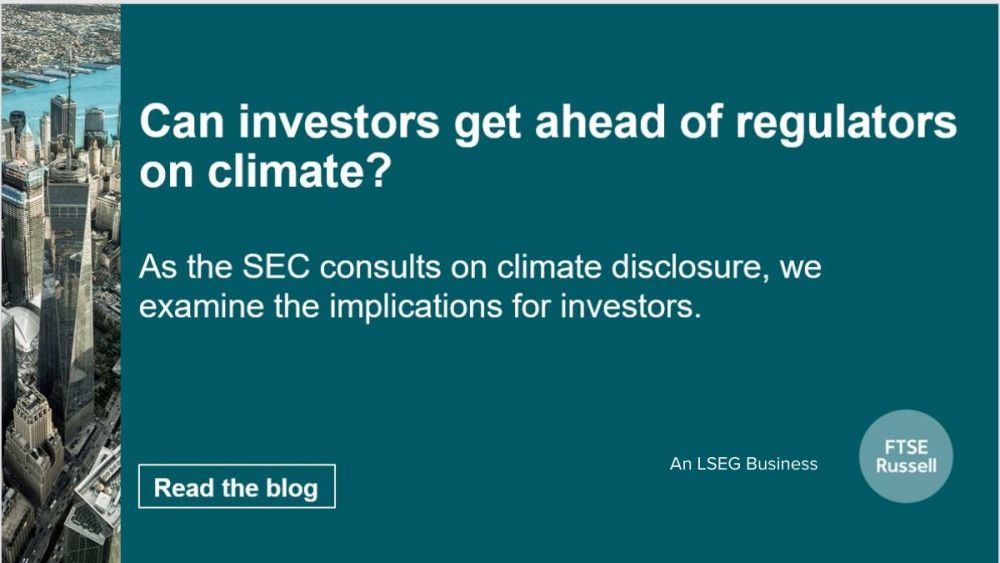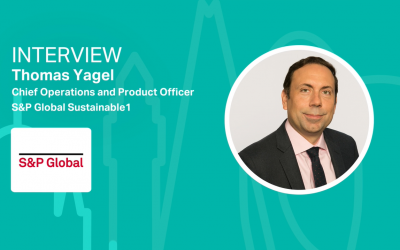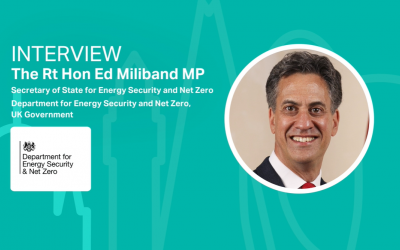Getting ahead of the SEC on climate risk and opportunity
The Securities and Exchange Commission (SEC) has made its move on climate risk disclosure. With the launch last month of a consultation on standardising climate-related disclosures by public companies, the US market regulator has set a train in process that will make it easier for investors to understand the risks and opportunities posed by the transition away from fossil fuels.

The Securities and Exchange Commission (SEC) has made its move on climate risk disclosure. With the launch last month of a consultation on standardising climate-related disclosures by public companies, the US market regulator has set a train in process that will make it easier for investors to understand the risks and opportunities posed by the transition away from fossil fuels.
This move is not before time. The United States trails other jurisdictions in requiring climate-related corporate disclosures. Meanwhile, the low-carbon transition is firmly underway. It is most visible in the energy and automotive sectors, where insurgent clean energy and electric vehicle companies are challenging the incumbents. Across a growing number of sectors, companies’ climate transition strategies provide a point of differentiation and are likely to drive future investment performance.
This poses a challenge for investors. The SEC process will take many months, if not years, to reach its conclusion. Whatever it decides will be contested in the courts. Investors are likely to face several more years of, in many cases, inadequate disclosure of investment-relevant climate information by issuers.
Fortunately, the market, both in the United States and beyond, has not waited for regulation. A range of market-led initiatives have seen investor collaborations, not-for-profit groups, academic institutions and financial data providers work to encourage disclosure, collect corporate climate information and develop investible products to help investors understand and respond to the low-carbon transition.
One of the most ambitious of these is the Transition Pathway Initiative (TPI). Led by asset owners, it uses data supplied by FTSE Russell to analyse how companies are managing climate risks and opportunities. Companies’ management quality is assessed against a series of indicators, covering issues such as company policy, emissions reporting, targets, strategic risk assessment and executive remuneration. Their carbon performance is also analysed, to understand whether their emissions trajectories are in line with scenarios such as consistency with national targets under the Paris Agreement, or with more ambitious targets that would hold global warming to below 2°C.
The data that TPI uses maps well to the information that the SEC is proposing that companies report. The SEC is calling on companies to report on the governance of climate risk, their direct carbon footprints and, where material, their indirect (Scope 3) emissions. It also wants to see companies discuss their transition plans.
Once collected and standardised, this data can be put to a range of uses by investors, including integration into active investment strategies, as a basis for engagement with company management, or to exclude poor performers.
Critically, it can also be used to construct benchmark indexes on which passive investment products can be based. Large, institutional investors increasingly recognise that they can’t respond to climate risk and opportunity without addressing their passive portfolios.
The New York State Common Retirement Fund (NYSCRF), the third-largest public pension fund in the United States, is one such investor. At the end of last year, it allocated US$2 billion of its assets to tracking the Russell 1000 TPI Climate Transition Index.
The index is designed to mimic the performance of the Russell 1000 benchmark but is weighted towards companies that perform well against the TPI assessment. It does not automatically exclude any companies or sectors, but overweighs climate leaders and underweights laggards. This means that the index has a carbon intensity (volumes of carbon dioxide emitted for each unit of revenue generated) some 40% below the Russell 1000 and is exposed to companies collectively holding 60% of the fossil fuel reserves of the benchmark.
The index also enhances exposure to companies based on how much of their revenue comes from the green economy. That means the companies providing the goods and services that will enable the transition to a low-carbon economy are not just included in the index but are overweighed compared with the benchmark.
Our Climate Transition Indexes are not designed to deliver alpha although, over the past five years, the Russell 1000 TPI Climate Transition Index has delivered an average annual return of 15.9%, compared with 15.8% by the Russell 1000 benchmark, with lower volatility. Instead, they are designed to help tilt portfolios towards the low-carbon transition, including those companies – regardless of sector – that are most successfully adapting to a net-zero global economy.
The move by the SEC to mandate climate risk disclosure will prove enormously helpful in the future in equipping investors with the information they need to understand that transition. But the message from NYSCRF is clear: the tools exist that can help them respond to climate risk and opportunity today.
Data as of March 31, 2022
To learn more about FTSE Russell click here.
© 2022 London Stock Exchange Group plc (the “LSE Group”). All information is provided for information purposes only. Such information and data is provided “as is” without warranty of any kind. No member of the LSE Group make any claim, prediction, warranty or representation whatsoever, expressly or impliedly, either as to the accuracy, timeliness, completeness, merchantability of any information or of results to be obtained from the use of FTSE Russell products or the fitness or suitability of the FTSE Russell products for any particular purpose to which they might be put. Any representation of historical data accessible through FTSE Russell products is provided for information purposes only and is not a reliable indicator of future performance. No member of the LSE Group provide investment advice and nothing contained in this document or accessible through FTSE Russell products should be taken as constituting financial or investment advice or a financial promotion. Use and distribution of the LSE Group data requires a licence from an LSE Group company and/or their respective licensors.






